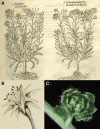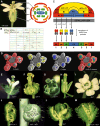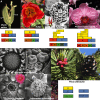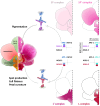Reflections on the ABC model of flower development
- PMID: 38345422
- PMCID: PMC11062442
- DOI: 10.1093/plcell/koae044
Reflections on the ABC model of flower development
Abstract
The formulation of the ABC model by a handful of pioneer plant developmental geneticists was a seminal event in the quest to answer a seemingly simple question: how are flowers formed? Fast forward 30 years and this elegant model has generated a vibrant and diverse community, capturing the imagination of developmental and evolutionary biologists, structuralists, biochemists and molecular biologists alike. Together they have managed to solve many floral mysteries, uncovering the regulatory processes that generate the characteristic spatio-temporal expression patterns of floral homeotic genes, elucidating some of the mechanisms allowing ABC genes to specify distinct organ identities, revealing how evolution tinkers with the ABC to generate morphological diversity, and even shining a light on the origins of the floral gene regulatory network itself. Here we retrace the history of the ABC model, from its genesis to its current form, highlighting specific milestones along the way before drawing attention to some of the unsolved riddles still hidden in the floral alphabet.
© The Author(s) 2024. Published by Oxford University Press on behalf of American Society of Plant Biologists.
Conflict of interest statement
Conflict of interest statement. None declared.
Figures






References
-
- Alvarez-Buylla ER, Ambrose BA, Flores-Sandoval E, Vergara-Silva F, Englund M, Garay-Arroyo A, Garcia-Ponce B, de la Torre-Barcena E, Espinosa-Matias S, Martinez E, et al. . B-function expression in the flower center underlies the homeotic phenotype of Lacandonia schismatica (Triuridaceae). Plant Cell. 2010:22(11):3543–3559. 10.1105/tpc.109.069153 - DOI - PMC - PubMed
Publication types
MeSH terms
Grants and funding
LinkOut - more resources
Full Text Sources

